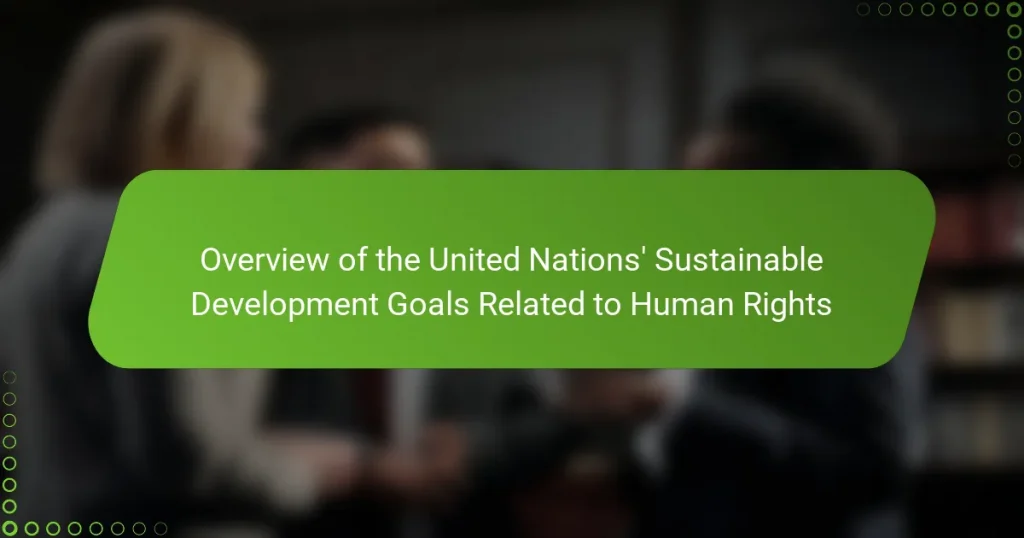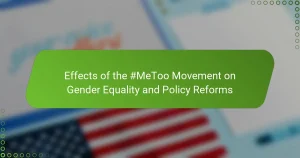The article provides an overview of the United Nations’ Sustainable Development Goals (SDGs) that specifically relate to human rights, focusing on Goal 5, Goal 10, and Goal 16. Goal 5 aims to achieve gender equality and empower all women and girls, addressing issues such as discrimination and violence. Goal 10 seeks to reduce inequality within and among countries, promoting social, economic, and political inclusion. Goal 16 emphasizes the importance of peaceful and inclusive societies, highlighting access to justice and the establishment of effective institutions. The article also discusses the challenges faced in achieving these goals, including funding limitations, political instability, and social inequalities, which hinder progress towards the promotion and protection of human rights globally.
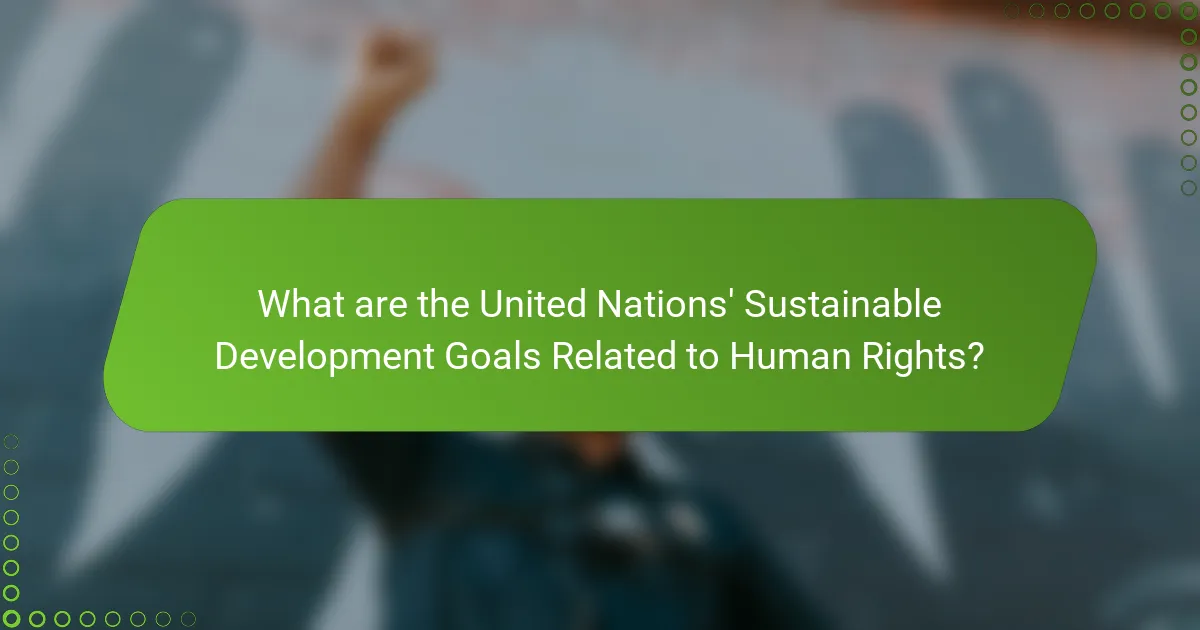
What are the United Nations’ Sustainable Development Goals Related to Human Rights?
The United Nations’ Sustainable Development Goals (SDGs) related to human rights are primarily Goal 10, Goal 16, and Goal 5. Goal 10 aims to reduce inequality within and among countries. It promotes social, economic, and political inclusion for all individuals. Goal 16 focuses on promoting peaceful and inclusive societies. It emphasizes access to justice and building effective, accountable institutions. Goal 5 is dedicated to achieving gender equality and empowering all women and girls. It addresses issues such as discrimination and violence against women. These goals collectively support the promotion and protection of human rights globally.
How do these goals align with the principles of human rights?
The United Nations’ Sustainable Development Goals (SDGs) align with human rights principles by promoting dignity, equality, and sustainability. Each goal addresses fundamental human needs, such as access to clean water, education, and healthcare. For example, Goal 1 aims to end poverty, which is a violation of the right to an adequate standard of living. Goal 4 focuses on quality education, reinforcing the right to education as a human right. Furthermore, Goal 5 promotes gender equality, ensuring women’s rights are respected and upheld. The integration of human rights in the SDGs is evident in their commitment to leaving no one behind, reflecting the core principle of universality in human rights. This alignment is crucial for fostering inclusive societies that respect and protect the rights of all individuals.
What specific human rights issues do the Sustainable Development Goals address?
The Sustainable Development Goals (SDGs) address various human rights issues. These include poverty eradication, gender equality, and access to education. They also focus on clean water and sanitation, health and well-being, and decent work conditions. The SDGs aim to reduce inequalities and promote sustainable cities and communities. Additionally, they emphasize responsible consumption and production patterns. Climate action is also a key focus, recognizing its impact on human rights. Lastly, the SDGs promote peace, justice, and strong institutions, which are fundamental for human rights.
How do the goals promote equality and justice?
The United Nations’ Sustainable Development Goals (SDGs) promote equality and justice by addressing systemic inequalities and advocating for inclusive policies. Goal 10 focuses on reducing inequality within and among countries. It aims to empower marginalized groups and ensure equal opportunities. Goal 5 emphasizes gender equality and the empowerment of women and girls. It seeks to eliminate discrimination and violence against women. Goal 16 promotes peaceful and inclusive societies, providing access to justice for all. It encourages the development of effective, accountable institutions. These goals are interconnected and collectively aim to create a fairer society. Evidence shows that countries implementing these goals see improvements in social equity and justice outcomes. For instance, nations that prioritize gender equality experience higher economic growth and social stability.
Why are these goals significant for global development?
The United Nations’ Sustainable Development Goals (SDGs) are significant for global development because they provide a comprehensive framework for addressing pressing global challenges. These goals aim to eradicate poverty, reduce inequalities, and promote sustainable economic growth. By setting measurable targets, the SDGs facilitate accountability and encourage collaboration among nations.
For example, Goal 1 focuses on ending poverty in all its forms everywhere, which is essential for improving living standards globally. Goal 5 aims to achieve gender equality and empower all women and girls, which is crucial for fostering inclusive societies. According to the UN, achieving these goals could lift over 700 million people out of extreme poverty by 2030.
The SDGs also emphasize the importance of human rights and social justice, which are foundational for sustainable development. By integrating these principles, the SDGs promote peace, stability, and resilience in communities worldwide. This comprehensive approach ensures that development efforts are inclusive and equitable, ultimately leading to a more sustainable and just world.
How do they impact vulnerable populations?
The United Nations’ Sustainable Development Goals (SDGs) significantly impact vulnerable populations by addressing systemic inequalities. These goals aim to eradicate poverty, ensure quality education, and promote gender equality. For instance, Goal 1 targets poverty reduction, which directly benefits low-income communities. Goal 4 focuses on inclusive education, helping marginalized children gain access to learning opportunities. Additionally, Goal 5 advocates for gender equality, empowering women and girls in underserved areas. Specific statistics show that achieving these goals could lift millions out of poverty and improve health outcomes. The UN reports that if fully implemented, the SDGs could reduce global poverty rates by up to 50% by 2030. Thus, the SDGs play a crucial role in uplifting vulnerable populations.
What role do these goals play in international law?
The United Nations’ Sustainable Development Goals (SDGs) play a crucial role in shaping international law. They provide a framework for countries to align their legal systems with global human rights standards. The SDGs emphasize the importance of accountability and the rule of law. They encourage states to enact legislation that promotes social justice and equality. This alignment helps to foster international cooperation and compliance with human rights treaties. For instance, Goal 16 specifically addresses the promotion of peaceful and inclusive societies. It calls for effective, accountable institutions at all levels. This goal directly influences the development of laws that protect human rights and prevent discrimination. By integrating the SDGs into national legal frameworks, countries can enhance their commitment to upholding human rights.
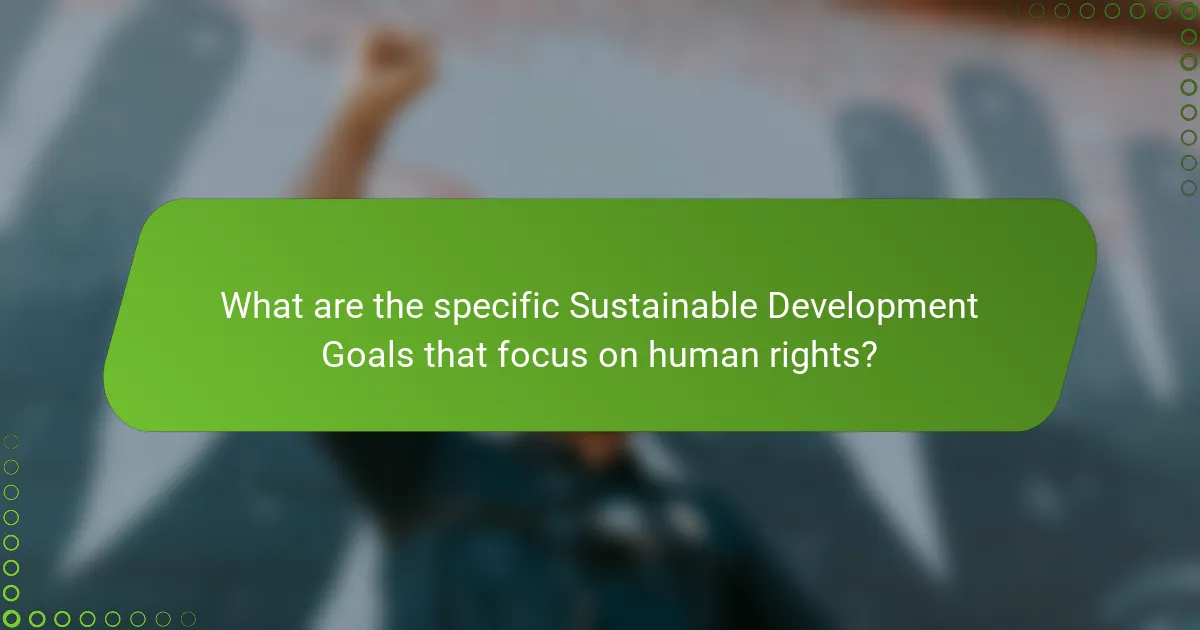
What are the specific Sustainable Development Goals that focus on human rights?
The specific Sustainable Development Goals (SDGs) that focus on human rights are Goal 5, Goal 10, and Goal 16. Goal 5 aims to achieve gender equality and empower all women and girls. It addresses issues such as discrimination, violence, and participation in leadership. Goal 10 seeks to reduce inequality within and among countries. It promotes social, economic, and political inclusion for all individuals. Goal 16 promotes peaceful and inclusive societies for sustainable development. It emphasizes access to justice and the establishment of effective, accountable institutions. These goals collectively highlight the importance of human rights in sustainable development.
Which goals directly address human rights issues?
The Sustainable Development Goals (SDGs) that directly address human rights issues include Goal 1, Goal 5, Goal 10, Goal 16, and Goal 17. Goal 1 aims to end poverty in all its forms everywhere, which is a fundamental human right. Goal 5 focuses on achieving gender equality and empowering all women and girls, addressing gender-based discrimination. Goal 10 seeks to reduce inequality within and among countries, promoting social, economic, and political inclusion. Goal 16 promotes peaceful and inclusive societies, ensuring access to justice for all and building effective institutions. Lastly, Goal 17 emphasizes partnerships for the goals, recognizing the importance of collaboration in addressing human rights challenges. These goals are interconnected and collectively contribute to advancing human rights globally.
What is Goal 1: No Poverty and its relation to human rights?
Goal 1: No Poverty aims to eradicate extreme poverty for all people everywhere. It emphasizes the human right to a standard of living adequate for health and well-being. This goal is linked to human rights as poverty undermines individuals’ ability to fulfill their rights. According to the United Nations, over 700 million people live on less than $1.90 a day, highlighting the urgent need for action. Poverty restricts access to education, healthcare, and social services, which are fundamental human rights. The Sustainable Development Goals recognize that alleviating poverty is essential for achieving equality and justice. Thus, Goal 1 addresses the intersection of poverty and human rights, advocating for dignity and respect for all individuals.
How does Goal 5: Gender Equality promote women’s rights?
Goal 5: Gender Equality promotes women’s rights by advocating for equal opportunities and treatment across all sectors. It aims to eliminate discrimination against women and girls. This goal supports women’s full participation in leadership and decision-making. It also addresses issues like violence against women and harmful practices. The United Nations reports that achieving gender equality can significantly improve economic growth. Studies show that countries with higher gender equality have better development outcomes. Therefore, Goal 5 directly contributes to the empowerment and protection of women’s rights globally.
How do these goals interconnect with each other?
The United Nations’ Sustainable Development Goals (SDGs) interconnect through their shared aim of promoting human rights and sustainable development. Each goal addresses different aspects of human well-being, such as poverty, education, and gender equality. For instance, Goal 1 (No Poverty) supports Goal 4 (Quality Education) by ensuring that individuals have the resources to pursue education. Similarly, Goal 5 (Gender Equality) enhances Goal 10 (Reduced Inequalities) by advocating for equal opportunities for all genders. The interdependence of these goals is evident; progress in one area often leads to advancements in others. For example, improving health (Goal 3) can boost economic growth (Goal 8), which in turn can help eliminate poverty (Goal 1). This interconnectedness is crucial for achieving a holistic approach to human rights and sustainable development.
What is the relationship between poverty and education in the context of human rights?
Poverty and education are closely linked in the context of human rights. Education is a fundamental human right that is essential for overcoming poverty. Individuals with higher education levels tend to have better job opportunities and income potential. According to UNESCO, each additional year of schooling can increase a person’s income by up to 10%. Conversely, poverty limits access to quality education. Children from low-income families often face barriers to educational resources. This creates a cycle where lack of education perpetuates poverty. The United Nations emphasizes education as a key factor in achieving Sustainable Development Goal 1, which aims to eradicate poverty in all forms. Thus, improving education can significantly reduce poverty levels and enhance human rights outcomes.
How does health access relate to economic rights?
Health access is intrinsically linked to economic rights as it is a fundamental aspect of human dignity and well-being. Economic rights encompass the right to work, fair wages, and an adequate standard of living. Access to healthcare enables individuals to maintain their health, thereby enhancing their ability to work and contribute economically. According to the World Health Organization, good health is essential for economic productivity and growth. Furthermore, the Universal Declaration of Human Rights emphasizes the right to a standard of living adequate for health and well-being, including medical care. Therefore, ensuring health access is crucial for the realization of economic rights and overall societal development.
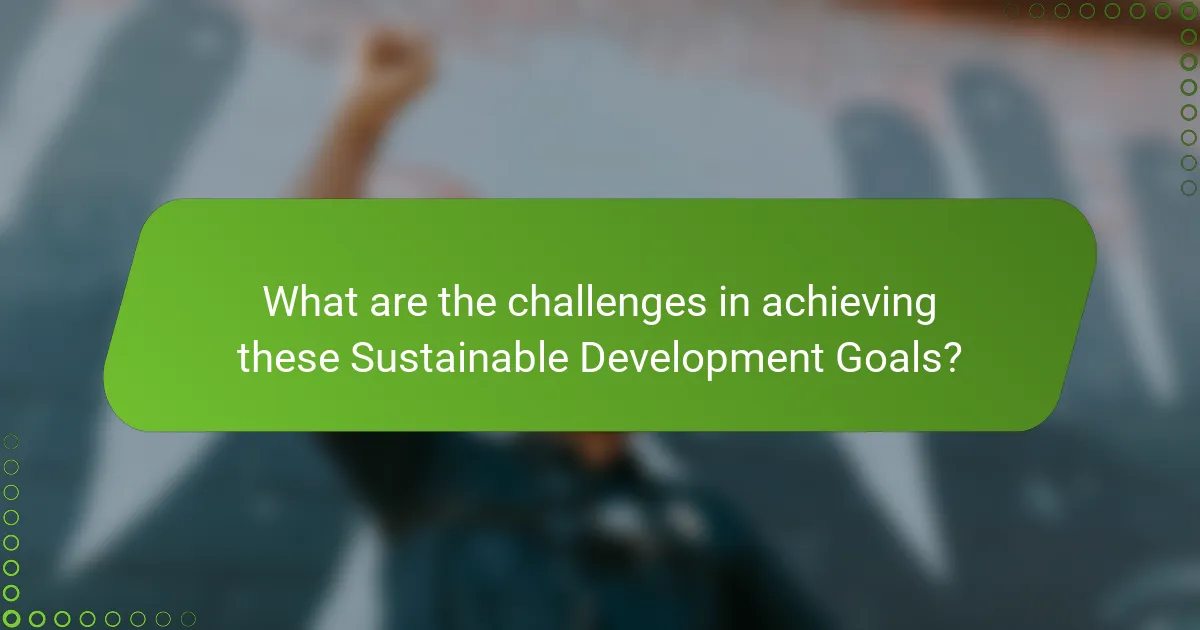
What are the challenges in achieving these Sustainable Development Goals?
Achieving Sustainable Development Goals (SDGs) faces multiple challenges. These challenges include inadequate funding and resources. Many countries lack the financial means to implement necessary programs. Political instability often hinders progress in various regions. Additionally, insufficient data and monitoring impede effective decision-making. Social inequalities also obstruct advancement towards the goals. Climate change presents a significant barrier, affecting vulnerable populations disproportionately. Lastly, lack of public awareness can limit community engagement in sustainable practices. Each of these challenges complicates the global effort to meet SDGs effectively.
What barriers exist in implementing human rights-focused goals?
Barriers in implementing human rights-focused goals include political resistance, lack of resources, and insufficient legal frameworks. Political resistance often stems from governments prioritizing economic growth over human rights. Lack of resources hinders the ability to fund programs and initiatives aimed at promoting these goals. Insufficient legal frameworks can prevent the enforcement of human rights protections. Additionally, cultural attitudes may conflict with human rights principles, impeding acceptance and implementation. These barriers collectively challenge the effectiveness of efforts to achieve human rights-focused Sustainable Development Goals.
How do political and economic factors hinder progress?
Political and economic factors hinder progress by creating barriers to implementation of sustainable development goals. Political instability often leads to inconsistent policies and governance challenges. Economic constraints can limit funding for essential programs and initiatives. Corruption diverts resources away from development efforts. Inequitable distribution of wealth exacerbates social disparities. Lack of political will can stall necessary reforms. Economic downturns reduce investment in critical infrastructure. These factors collectively impede the advancement of human rights and sustainable development initiatives.
What role does public awareness play in the success of these goals?
Public awareness is crucial for the success of the United Nations’ Sustainable Development Goals (SDGs) related to human rights. It fosters understanding and engagement among individuals and communities. Increased awareness encourages public participation in advocacy and policy-making. Research shows that informed citizens are more likely to support initiatives that promote human rights. For example, campaigns that raise awareness about gender equality have led to increased support for policies addressing gender-based violence. Furthermore, public awareness can drive accountability by pressuring governments and organizations to uphold human rights standards. Ultimately, a well-informed public is essential for achieving the SDGs and ensuring sustainable progress in human rights.
What strategies can be employed to overcome these challenges?
To overcome challenges related to the United Nations’ Sustainable Development Goals (SDGs) on human rights, strategies include strengthening legal frameworks and promoting accountability. Legal frameworks must be updated to align with international human rights standards. This ensures protection for vulnerable populations. Promoting accountability involves holding violators responsible through judicial systems. Capacity building for local institutions enhances their ability to implement human rights policies. Engaging civil society organizations fosters community participation in monitoring and advocacy efforts. Strengthening international cooperation can provide necessary resources and support for implementation. Education and awareness campaigns increase public understanding of human rights issues. All these strategies contribute to a holistic approach in addressing the challenges of the SDGs related to human rights.
How can stakeholders collaborate to enhance goal achievement?
Stakeholders can collaborate to enhance goal achievement by establishing clear communication channels. Effective communication ensures that all parties understand their roles and responsibilities. Regular meetings can facilitate the exchange of ideas and progress updates. Collaborative platforms can be utilized to share resources and best practices. Joint initiatives can leverage diverse expertise to tackle complex issues. Stakeholders can align their objectives with the Sustainable Development Goals to ensure a unified approach. By fostering partnerships, stakeholders can pool resources for greater impact. Evidence shows that collaborative efforts lead to improved outcomes in achieving human rights goals.
What practical steps can individuals take to support the Sustainable Development Goals related to human rights?
Individuals can support the Sustainable Development Goals related to human rights by advocating for equality and justice. They can educate themselves about human rights issues locally and globally. Sharing this knowledge with others raises awareness. Volunteering for organizations that promote human rights can create direct impact. Individuals should also participate in peaceful protests and campaigns that align with these goals. Supporting businesses that uphold fair labor practices contributes to economic justice. Additionally, engaging with policymakers through petitions and voting can influence legislation. These actions collectively advance the protection and promotion of human rights.
The main entity of this article is the United Nations’ Sustainable Development Goals (SDGs) related to human rights. The article provides an overview of specific SDGs, including Goal 5 (gender equality), Goal 10 (reduced inequalities), and Goal 16 (peace, justice, and strong institutions), highlighting their significance in promoting human rights and addressing issues such as poverty, discrimination, and access to education. It explains how these goals align with human rights principles and their impact on vulnerable populations while discussing the challenges and barriers to achieving these goals. Additionally, the article outlines strategies for collaboration among stakeholders and practical steps individuals can take to support these human rights-focused SDGs.
